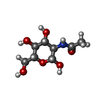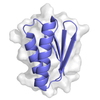[English] 日本語
 Yorodumi
Yorodumi- EMDB-37532: Structure of hemagglutinin from Asiatic toad influenza-like virus -
+ Open data
Open data
- Basic information
Basic information
| Entry |  | |||||||||
|---|---|---|---|---|---|---|---|---|---|---|
| Title | Structure of hemagglutinin from Asiatic toad influenza-like virus | |||||||||
 Map data Map data | ||||||||||
 Sample Sample |
| |||||||||
 Keywords Keywords | Hemagglutinin / VIRAL PROTEIN | |||||||||
| Function / homology | Haemagglutinin, influenzavirus B / Haemagglutinin / Haemagglutinin, influenzavirus A/B / host cell surface receptor binding / endocytosis involved in viral entry into host cell / fusion of virus membrane with host plasma membrane / viral envelope / membrane / Hemagglutinin Function and homology information Function and homology information | |||||||||
| Biological species |  Wuhan asiatic toad influenza virus Wuhan asiatic toad influenza virus | |||||||||
| Method | single particle reconstruction / cryo EM / Resolution: 2.65 Å | |||||||||
 Authors Authors | Zhang D / Xie YF / Chai Y / Shi Y / Liu WJ / Qi JX / Gao GF / Gao F | |||||||||
| Funding support |  China, 1 items China, 1 items
| |||||||||
 Citation Citation |  Journal: To be published Journal: To be publishedTitle: Structure of hemagglutinin from Asiatic toad influenza-like virus Authors: Hao T / Xie Y / Chai Y / Zhang W / Zhang D / Qi J / Shi Y / Song H / Gao GF | |||||||||
| History |
|
- Structure visualization
Structure visualization
| Supplemental images |
|---|
- Downloads & links
Downloads & links
-EMDB archive
| Map data |  emd_37532.map.gz emd_37532.map.gz | 167.3 MB |  EMDB map data format EMDB map data format | |
|---|---|---|---|---|
| Header (meta data) |  emd-37532-v30.xml emd-37532-v30.xml emd-37532.xml emd-37532.xml | 19.4 KB 19.4 KB | Display Display |  EMDB header EMDB header |
| Images |  emd_37532.png emd_37532.png | 58.5 KB | ||
| Filedesc metadata |  emd-37532.cif.gz emd-37532.cif.gz | 6.3 KB | ||
| Others |  emd_37532_half_map_1.map.gz emd_37532_half_map_1.map.gz emd_37532_half_map_2.map.gz emd_37532_half_map_2.map.gz | 165.1 MB 165.1 MB | ||
| Archive directory |  http://ftp.pdbj.org/pub/emdb/structures/EMD-37532 http://ftp.pdbj.org/pub/emdb/structures/EMD-37532 ftp://ftp.pdbj.org/pub/emdb/structures/EMD-37532 ftp://ftp.pdbj.org/pub/emdb/structures/EMD-37532 | HTTPS FTP |
-Validation report
| Summary document |  emd_37532_validation.pdf.gz emd_37532_validation.pdf.gz | 773.1 KB | Display |  EMDB validaton report EMDB validaton report |
|---|---|---|---|---|
| Full document |  emd_37532_full_validation.pdf.gz emd_37532_full_validation.pdf.gz | 772.7 KB | Display | |
| Data in XML |  emd_37532_validation.xml.gz emd_37532_validation.xml.gz | 15.4 KB | Display | |
| Data in CIF |  emd_37532_validation.cif.gz emd_37532_validation.cif.gz | 18.1 KB | Display | |
| Arichive directory |  https://ftp.pdbj.org/pub/emdb/validation_reports/EMD-37532 https://ftp.pdbj.org/pub/emdb/validation_reports/EMD-37532 ftp://ftp.pdbj.org/pub/emdb/validation_reports/EMD-37532 ftp://ftp.pdbj.org/pub/emdb/validation_reports/EMD-37532 | HTTPS FTP |
-Related structure data
| Related structure data |  8wh7MC  8wisC  9w44C M: atomic model generated by this map C: citing same article ( |
|---|---|
| Similar structure data | Similarity search - Function & homology  F&H Search F&H Search |
- Links
Links
| EMDB pages |  EMDB (EBI/PDBe) / EMDB (EBI/PDBe) /  EMDataResource EMDataResource |
|---|---|
| Related items in Molecule of the Month |
- Map
Map
| File |  Download / File: emd_37532.map.gz / Format: CCP4 / Size: 178 MB / Type: IMAGE STORED AS FLOATING POINT NUMBER (4 BYTES) Download / File: emd_37532.map.gz / Format: CCP4 / Size: 178 MB / Type: IMAGE STORED AS FLOATING POINT NUMBER (4 BYTES) | ||||||||||||||||||||||||||||||||||||
|---|---|---|---|---|---|---|---|---|---|---|---|---|---|---|---|---|---|---|---|---|---|---|---|---|---|---|---|---|---|---|---|---|---|---|---|---|---|
| Projections & slices | Image control
Images are generated by Spider. | ||||||||||||||||||||||||||||||||||||
| Voxel size | X=Y=Z: 0.86 Å | ||||||||||||||||||||||||||||||||||||
| Density |
| ||||||||||||||||||||||||||||||||||||
| Symmetry | Space group: 1 | ||||||||||||||||||||||||||||||||||||
| Details | EMDB XML:
|
-Supplemental data
-Half map: #1
| File | emd_37532_half_map_1.map | ||||||||||||
|---|---|---|---|---|---|---|---|---|---|---|---|---|---|
| Projections & Slices |
| ||||||||||||
| Density Histograms |
-Half map: #2
| File | emd_37532_half_map_2.map | ||||||||||||
|---|---|---|---|---|---|---|---|---|---|---|---|---|---|
| Projections & Slices |
| ||||||||||||
| Density Histograms |
- Sample components
Sample components
-Entire : Toad Hemagglutinin
| Entire | Name: Toad Hemagglutinin |
|---|---|
| Components |
|
-Supramolecule #1: Toad Hemagglutinin
| Supramolecule | Name: Toad Hemagglutinin / type: complex / ID: 1 / Parent: 0 / Macromolecule list: #1 |
|---|---|
| Source (natural) | Organism:  Wuhan asiatic toad influenza virus Wuhan asiatic toad influenza virus |
-Macromolecule #1: Hemagglutinin
| Macromolecule | Name: Hemagglutinin / type: protein_or_peptide / ID: 1 / Number of copies: 3 / Enantiomer: LEVO |
|---|---|
| Source (natural) | Organism:  Wuhan asiatic toad influenza virus Wuhan asiatic toad influenza virus |
| Molecular weight | Theoretical: 54.95159 KDa |
| Recombinant expression | Organism:  |
| Sequence | String: NQICIGKAIK PINGTVETVS RMAKVTGMKK VGGERMQKIC AKGEQIHDSS SACGIVSHHL KQEGCDFPFL LNKPKFATTG PMNTSTTGF NFYLTEKAKS WMNITWRVLG ENKDFGDNLV EKYGESGATS EGATLKNYYW YVPTAKPGPV VYEKLAECTG T IYYGALLS ...String: NQICIGKAIK PINGTVETVS RMAKVTGMKK VGGERMQKIC AKGEQIHDSS SACGIVSHHL KQEGCDFPFL LNKPKFATTG PMNTSTTGF NFYLTEKAKS WMNITWRVLG ENKDFGDNLV EKYGESGATS EGATLKNYYW YVPTAKPGPV VYEKLAECTG T IYYGALLS DAEAGYIAVT GRNVTERWDV RFTGSSESSI SFSGPKQSPM EEYIIKSVRS SVDTVRNIII LDSGRVKKGE TF SISLSSG AVVIPTIFCD GDFAVTPQVQ IDKDCASDCH SAYGSFPNGS SFIIHHSVHT VGSCPPSILR NFDVIDGYEA TWE ETKQSR GFFGAILGFF TGGIQGAIDG WYGVTNHDTG KGTAADQTST QKAVEAITNK LNEAIENGNQ RYNQLYGLAR TQAE LLGNL GKEVNDLRLE TFTEFIRLET ILVNTRIIEE HQAIGSKKKE EVKRLLGPNA LDLGNGCFNL THTCDSNCVN SISRG TYTR ENYIHNVTLA GTPKIDGVV UniProtKB: Hemagglutinin |
-Macromolecule #4: 2-acetamido-2-deoxy-beta-D-glucopyranose
| Macromolecule | Name: 2-acetamido-2-deoxy-beta-D-glucopyranose / type: ligand / ID: 4 / Number of copies: 12 / Formula: NAG |
|---|---|
| Molecular weight | Theoretical: 221.208 Da |
| Chemical component information |  ChemComp-NAG: |
-Experimental details
-Structure determination
| Method | cryo EM |
|---|---|
 Processing Processing | single particle reconstruction |
| Aggregation state | particle |
- Sample preparation
Sample preparation
| Buffer | pH: 8 |
|---|---|
| Vitrification | Cryogen name: ETHANE |
- Electron microscopy
Electron microscopy
| Microscope | FEI TITAN KRIOS |
|---|---|
| Image recording | Film or detector model: FEI FALCON IV (4k x 4k) / Average electron dose: 49.0 e/Å2 |
| Electron beam | Acceleration voltage: 300 kV / Electron source:  FIELD EMISSION GUN FIELD EMISSION GUN |
| Electron optics | Illumination mode: FLOOD BEAM / Imaging mode: BRIGHT FIELD / Nominal defocus max: 2.0 µm / Nominal defocus min: 1.0 µm |
| Experimental equipment |  Model: Titan Krios / Image courtesy: FEI Company |
 Movie
Movie Controller
Controller










 Z (Sec.)
Z (Sec.) Y (Row.)
Y (Row.) X (Col.)
X (Col.)




































